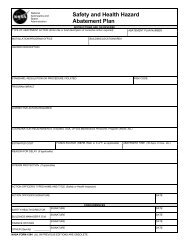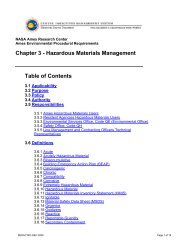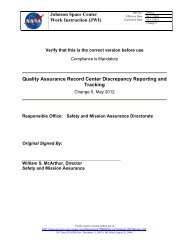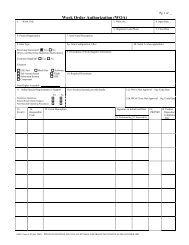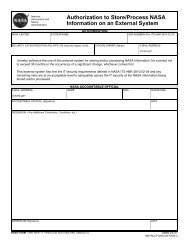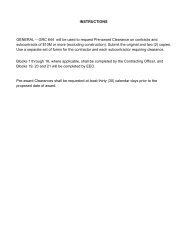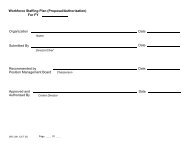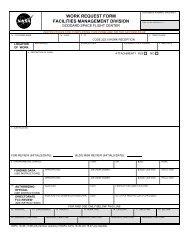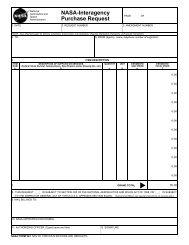JPR 8550.1 - Nasa
JPR 8550.1 - Nasa
JPR 8550.1 - Nasa
Create successful ePaper yourself
Turn your PDF publications into a flip-book with our unique Google optimized e-Paper software.
JSC Environmental Compliance<br />
Procedural Requirements<br />
<strong>JPR</strong> No.<br />
<strong>8550.1</strong>A XXXX.X<br />
Effective Date:<br />
Johnson Space Center • Environmental Compliance Program<br />
Expiration Date:<br />
Expiration Date:<br />
Page Number<br />
3/25/2011<br />
3/25/2016<br />
[Leave Blank]<br />
Page 109 of 123<br />
14.3 Container Type<br />
a. The container must be compatible with the type of waste it will contain. For example, do not<br />
place acid in a steel drum. The acid will corrode the steel container and cause a possible leak<br />
or spill. Glass containers shall not be used when plastic or other unbreakable materials are<br />
appropriate and available.<br />
b. Regardless of container type, all employees shall comply with all the waste accumulation<br />
requirements in Chapter 3, Managing Industrial Solid Waste, including:<br />
(1) Containers shall be kept closed at all times, except when adding wastes;<br />
(2) Each container shall be labeled with the name or description of the contents;<br />
(3) The exterior of the container shall be clean, and<br />
(4) The container shall be in good condition (not leaking, excessively corroded, or otherwise<br />
show evidence of deterioration; contact the EO if the container requires over packing.<br />
14.4 Container Size<br />
Select the smallest practical size of container in order to minimize the amount of waste that you<br />
accumulate before calling for pickup and disposal. Waste containers come in different sizes and<br />
materials. 5-gallon polyethylene, 55-gallon polyethylene, and 55-gallon steel containers are<br />
available by calling Facilities Work Control.<br />
14.5 Accumulation Location<br />
14.5.1 Outside Waste Accumulation<br />
Wastes should be accumulated in a location that is secure and appropriate. Waste containers<br />
should be stored in locations protected from the weather when possible. Drums will rust over<br />
time, labels will fade in sunlight, and any waste that may be on the exterior of the container will<br />
get into storm water during rain. If waste is stored outdoors and in large quantities (55 gallons<br />
or more), containment will need to be provided that will hold the waste and any rainwater if the<br />
container should leak. More information on waste accumulation areas is provided in Chapter 3,<br />
Managing Industrial Solid Waste.<br />
14.5.2 Vent Hoods<br />
Waste accumulation containers shall not be stored in vent hoods unless there is no other safe<br />
alternative.<br />
14.6 Accumulation Time<br />
a. Wastes shall not be accumulated for more than 6 months.<br />
b. Laboratories shall not accumulate wastes for more than 3 months.<br />
Verify correct version before use at<br />
http://server-mpo.arc.nasa.gov/Services/CDMSDocs/Centers/JSC/Home.tml.<br />
JSC Form JF2420B (MS Word August 28, 2006) (Revised May 30, 2007)



